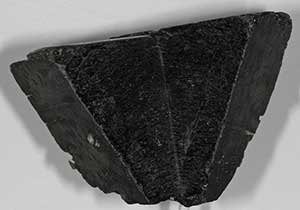 |
| Wolframite - (Fe,Mn)WO4. |
Tungsten is a gray-white metallic element. It has the highest melting temperature of all elements except carbon and is one of the heaviest elements. Tungsten is produced from the ore minerals scheelite (calcium tungstate) and wolframite (iron-manganese tungstate). The United States does not have any operating tungsten mines; tungsten powder and other tungsten materials are produced in the United States from various imported tungsten-bearing materials and from recycled scrap. Most of the imports come from China and Russia. Tungsten is used in cemented carbide parts for cutting and wear-resistant materials primarily in the construction, gas and oil drilling industries, metalworking, and mining. Some tungsten was also used to make chemicals for catalysts and pigments, electrodes and other components for the electric and electronic industries, lamp filaments, and steels.
Background
Tungsten is a gray-white metallic element. Its atomic number is 74 and its atomic symbol is W (after the German name Wolfram given to this element). It is stable and is very resistant to acids and bases. It does, however, oxidize in air, especially at higher temperatures. It has the highest melting temperature of any metal (3422 degrees C, 6192 degrees F), and the second highest of all elements (Carbon is highest).
Tungsten was discovered in 1758 by Axel Fredrik Cronstadt; in 1781 Carl Wilhelm Scheele isoldated a tungsten oxide, and in 1783 the Spanish chemists (and brothers) Fausto and Juan Jose de Elhuyar first separated tungsten from the mineral wolframite.
It is interesting to note that tungsten is important to the health of plants and animals. Specifically, it is used by some enzymes called oxidoreductases.
Name
Tungsten was named from the Swedish words "tung sten" meaning "heavy stone."
Sources
Tungsten is retrieved from the ore minerals scheelite (CaWO4, calcium tungstate) and wolframite ((Fe,Mn)WO4, iron-manganese tungstate). Of the world's tungsten reserves, over 90% are outside the United States. Of these resources, nearly half are found in China, and Canada and Russia also have large reserves. About one-third of the U.S. imports of tungsten are from China, Russia provides about 25%, and a variety of other nations provide the rest. A significant amount of tungsten is recovered through recycling of scrap tungsten products. Recycled tungsten in the US accounts for nearly one-third of the tungsten consumed. Major production of tungsten concentrates come from Austria, Bolivia, Canada, China, Portugal, and Russia.
Uses
Tungsten is mixed with carbon to make a very strong, very resistant material called tungsten carbide. Tungsten carbide is used to make cutting tools and wear-resistant tools for metalworking, drilling for oil and gas, mining, and construction. These applications account for more than 60% of the tungsten consumed in the US each year.
Because it has such a very high melting point and low vapor pressure, tungsten is used in high temperature situations. For instance, the filaments in light bulbs are made of tungsten. It is used in other applications in electronics as well.
When added to steel, tungsten increases its strength. It is alloyed (mixed with) other metals to make "superalloys" which have special physical properties of high strength and heat resistance. Some of the applications for such superalloys are in turbine engines for jet aircraft and energy generation.
Other alloys bearing tungsten are used for armaments, heat sinks, radiation shielding, weights and counterweights, wear-resistant parts and coatings.
Substitutes and Alternative Sources
Tungsten is the only material used to make light bulb filaments. Experiments are being done with ceramic and ceramics mixed with metals to create alternative cutting materials. Cemented carbide made with tungsten carbide is still preferred to these materials.